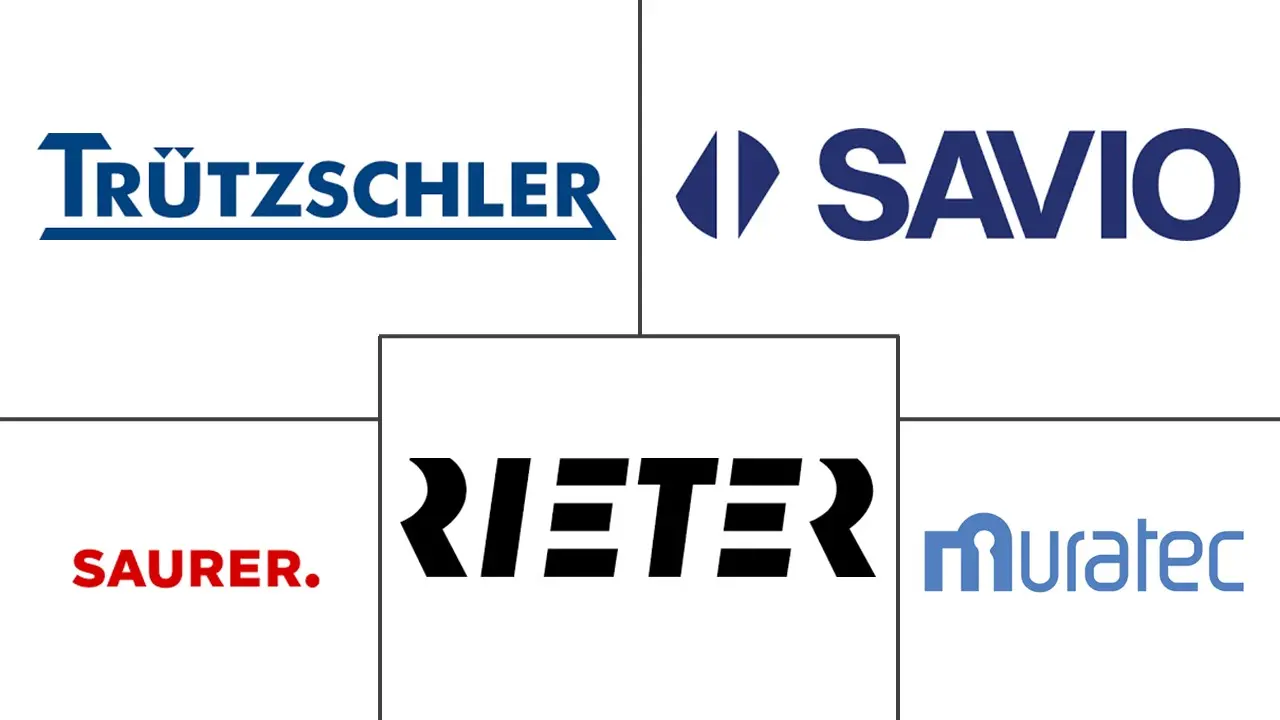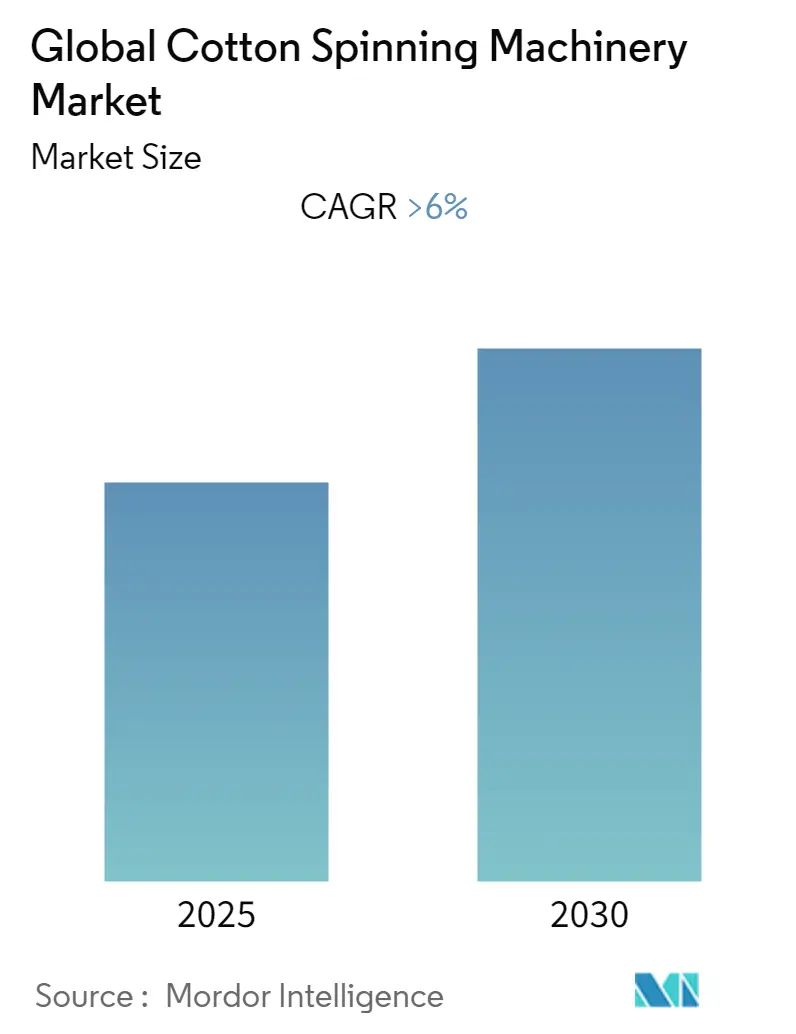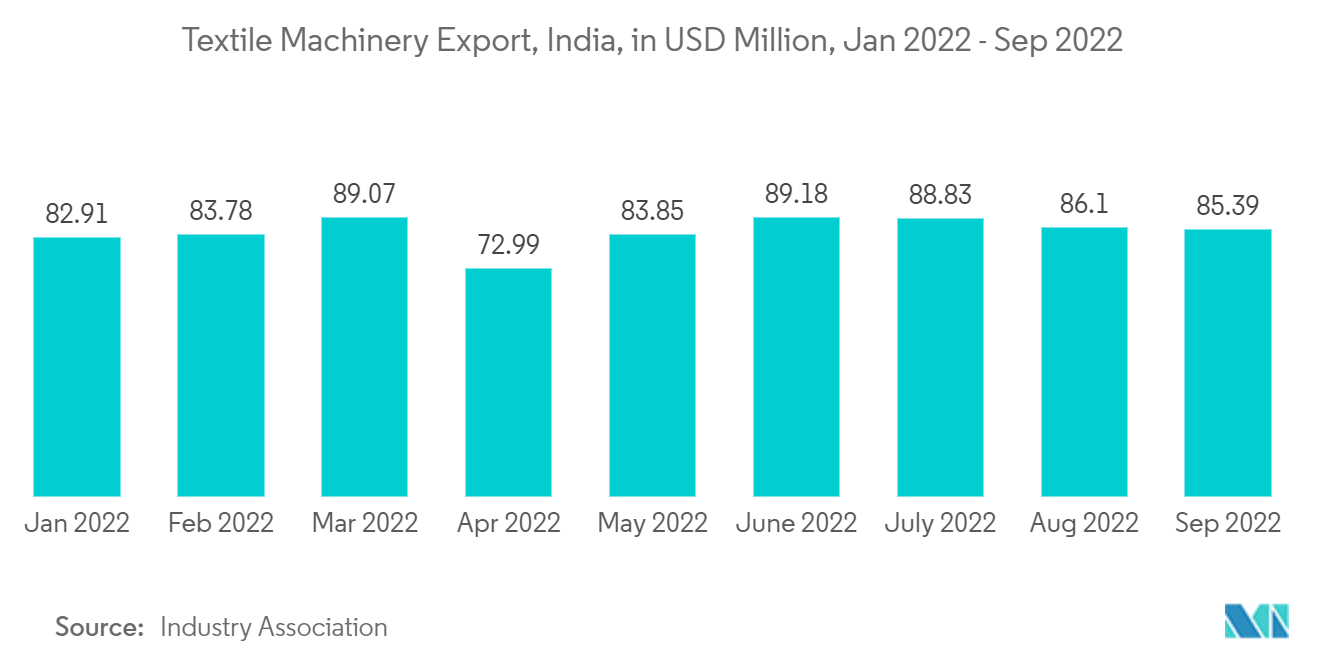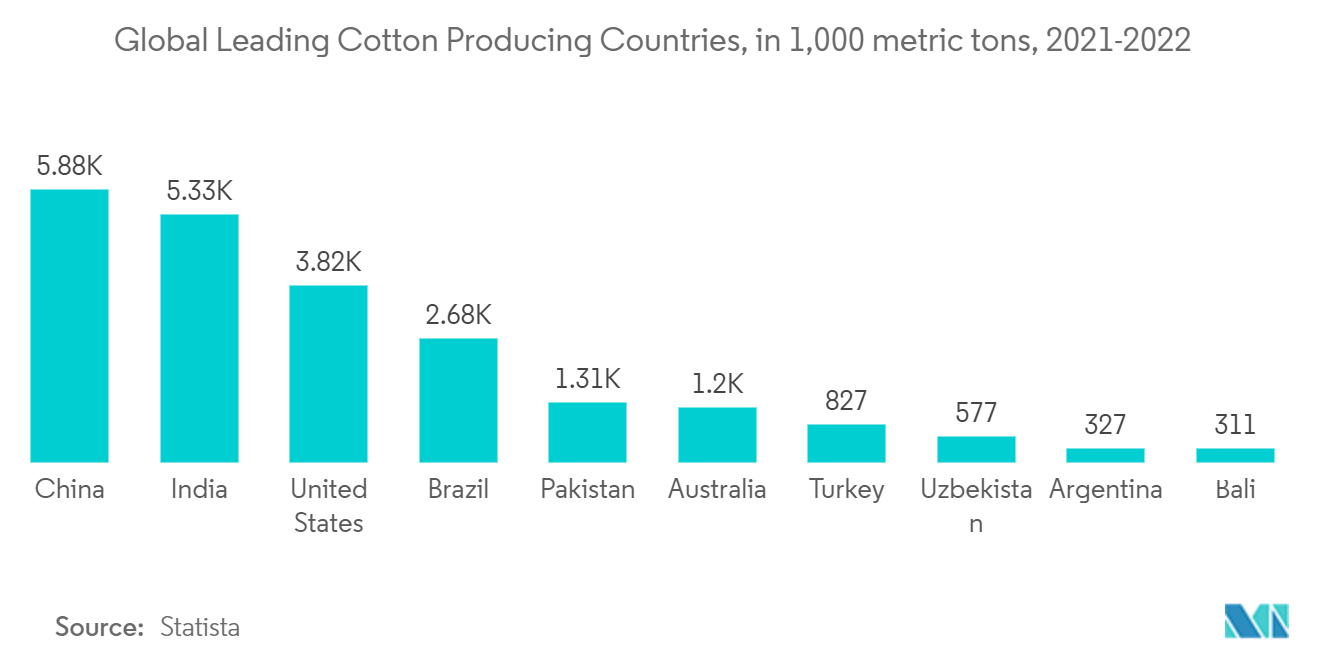Cotton Spinning Machinery Market Analysis
The Global Cotton Spinning Machinery Market is expected to register a CAGR of greater than 6% during the forecast period.
- There is a rise in demand for natural fabrics such as cotton which is one of the main factors driving the market. Furthermore, the increasing domestic demand for cotton textiles in Asia-Pacific is driving the market due to the high demand for machinery by the local mills.
- The future looks bright for spinning linen mills, thanks to the rapid growth in demand for fabrics for ready-made clothing. Spinners can currently produce a large portion of the raw material required for the knitwear and woven segments. However, spinning cotton mills are looking to expand their production capacity to meet rising demand. Bangladesh is one of the leading exporters of apparel raw materials. To meet these rising export demands, the Bangladeshi government has also taken steps to assist spinning mills in producing more raw materials for export to other countries. This initiative has greatly aided Bangladesh, as countries such as South Korea, Turkey, and Egypt collaborate with the Bangladesh Textile Mills Association to purchase raw materials from the country.
- The domestic market is expanding as India and other countries in Asia-Pacific have surpassed countries such as the United States and Japan in terms of consumption. The local market is expanding as consumers shift away from need-based purchasing and toward aspiration-based purchasing. Another factor enabling domestic market growth is the increasing participation of women in the labour force, as well as India's steady rise to become one of the world's largest e-commerce markets. Shorter lead times and higher-quality raw materials produced by local spinners are attracting an increasing number of companies to purchase fabrics from them. When sourcing from the local market, it takes less time.
- Over time, technology has played an important role in increasing the success of spinning cotton mills. More than ever before, industries are striving for perfection. Quality is critical to please and satisfy customers. Mills are harnessing the power of technology to achieve high levels of precision. Changes brought about by technology also enable cost-effectiveness. Labor, maintenance, and production costs are reduced by the new technology. Better energy sources are used by machinery. Knowing the benefits of solar energy, spinning linen and cotton mills are gradually transitioning to it. Clothing trends are changing at a rapid pace nowadays. Mills rely heavily on technology to keep up with these changes. Spinning cotton mills use artificial intelligence to produce raw materials that are precisely tailored to the preferences of customers all over the world.
- New investments are creating new opportunities for linen and cotton mills. Spinners are increasing their investments, and new mills are opening to help meet the increasing number of orders. This increased manufacturing capacity will result in increased investment in the textile industry. The spinning sector will receive a significant portion of these investments, while the dyeing and finishing processes will receive the remainder. Jinnat Spinning Mills Limited, Karim Tex Limited, and Mahin Group are among the new companies planning to invest in spinners. These organizations are collectively investing billions of dollars to boost yarn production in mills.
Cotton Spinning Machinery Market Trends
Increasing domestic demand for cotton fabric in Asia-Pacific driving the market
Cotton is the most commonly used natural fibre in the world, making it an important component of the textile industry. The total global cotton production in 2020/2021 was 112.39 million bales. India, China, and the United States were the world's largest producers, accounting for more than half of the total production volume. In 2021, the total global supply of cotton, including stocks, was estimated to be around 247.6 million bales. The United States was the leading cotton exporter in 2021, with approximately 16.35 million bales of cotton exported worldwide. As a result, the United States exported the vast majority of its harvests for processing elsewhere. Brazil, India, and Australia were also among the top exporters. China, Bangladesh, and Vietnam were among the top importers, all of which are well-known for their production of large quantities of cotton clothing.
China, India, and the United States are the top three cotton-producing countries. The Southern states have traditionally harvested the most cotton in the United States. This area was once known as the "Cotton Belt," because cotton was the most important cash crop from the 18th to the 20th centuries. Cotton production has declined due to soil depletion and social and economic changes, and agricultural land in this region are now primarily used for crops such as corn, soybeans, and wheat. This statistic depicts the top cotton-producing countries in the year 2021/2022. Cotton production in China that year was estimated to be around 5.88 million metric tons.
A near-doubling in benchmark cotton futures to 11-year highs, coupled with an increase in freight and fuel prices, is hammering Asian apparel makers, while global retail customers are hesitant to absorb the additional costs. Losses have piled up for Asia's garment manufacturers, who are among the region's largest employers, with some smaller units suspending operations, displacing thousands of workers, undermining the region's recovery from the pandemic and posing a new challenge for policymakers already dealing with high inflation. An uncertain outlook for European demand amid the Russia-Ukraine conflict has exacerbated the woes of apparel makers in Asia, which is home to the world's top garment exporters, China and Bangladesh.
Increasing Production of Cotton Textiles in Emerging Regions
Cotton production in India is expected to reach 7.2 million tonnes (43 million bales of 170 kg each) by 2030, owing to rising consumer demand. In FY22, India's textile and apparel exports (including handicrafts) totalled USD 44.4 billion, a 41% increase year on year. In FY22, readymade garment exports including cotton accessories totalled USD 6.19 billion. In comparison to major textile producers, India has a comparative advantage in terms of skilled labour and production costs. The textiles sector is dominated by the decentralised power looms/hosiery and knitting sector. The textile industry's close relationship with agriculture (for raw materials such as cotton) and the country's ancient textile culture and traditions make it unique in the world.
In 2023, the world's largest textile-producing countries and top textile exporters will continue to drive global textile industry growth, owing to rising production and sales of materials such as cotton, yarn, fibre, and other finished products or apparel. While China continues to be the world's largest textile producer and exporter, other major textile markets such as the EU, India, and the United States have shown impressive annual growth rates in recent years. The global textile industry is expected to grow in lockstep with the rapidly changing fashion markets around the world, implying that the world's largest textile-producing countries and top textile exporters still have plenty of room to grow during the forecast period.
Cotton Spinning Machinery Industry Overview
The Global Cotton Spinning Machinery Market is fragmented with the presence of a large number of local and regional players, as well as global players. Some major players include Rieter AG, Saurer Schlafhorst GmbH & CO. KG, Trutzschler group, Muratec Murata Machinery, Ltd., and Savio Macchine Tessili S.p.A., including many others. Technology innovation and huge demand is the main factor driving the market. This has attracted many companies to enter the market, but supply chain issues and high fuel prices are some of the challenges the market needs to overcome.
Cotton Spinning Machinery Market Leaders
-
Rieter AG
-
Saurer Schlafhorst GmbH & CO. KG
-
Trutzschler group
-
Muratec Murata Machinery, Ltd.
-
Savio Macchine Tessili S.p.A.
- *Disclaimer: Major Players sorted in no particular order
Cotton Spinning Machinery Market News
- November 2022: Valérius 360, a Portuguese textile supplier, has collaborated with Trutzschler, a German spinning technology company, to improve the quality of recycled cotton yarns made from a 50:50 blend of recycled and virgin cotton. Using cotton waste from Valérius' spinning and knitting operations in Barcelo, Portugal, technicians discovered that a direct spinning process produced significantly higher-quality recycled yarn than a draw frame passage for rotor spun yarns. Yarn breaks were reduced by up to one-third, and energy consumption was reduced as well.
- August 2022: Matin Spinning Mills PLC, a DBL Group company, inaugurated its special yarn unit in Kashimpur, Gazipur, Bangladesh, with a capacity of 10 tonnes per day of special yarn to meet the growing demand for high-quality yarn. The special yarn unit will be one of Bangladesh's most modern spinning mills, with machinery from Rieter in Switzerland, Toyota & Murata in Japan, Luwa in Switzerland, and others.
Cotton Spinning Machinery Industry Segmentation
Spinning is the process of winding drawn-out strands of fiber together to form a yarn. It is a significant component of the textile industry. Spinning is used in the production of various textile fibers. Ring, Rotor, and Air-jet spinners are the three types of spinners used in the textile industry. A complete background analysis of the Global Cotton Spinning Machinery Market, including the assessment of the economy and contribution of sectors in the economy, market overview, market size estimation for key segments, and emerging trends in the market segments, market dynamics, and geographical trends, and COVID-19 impact, is covered in the report.
The Global Cotton Spinning Machinery Market is segmented By Type (Ring Spinning, Compact Spinning, Rotor Spinning, and Air Jet Spinning), By Application (Clothing, Textile, and Other Industries), and By Geography (North America, Asia-Pacific, Europe, Middle East & Africa and South America). The report offers the market size and forecasts value (USD billion) for all the above segments.
| By Type | Ring Spinning | ||
| Compact Spinning | |||
| Rotor Spinning | |||
| Air Jet Spinning | |||
| By Application | Clothing | ||
| Textile | |||
| Other Industries | |||
| By Geography | North America | United States | |
| Canada | |||
| Mexico | |||
| Europe | Germany | ||
| France | |||
| United Kingdom | |||
| Italy | |||
| Spain | |||
| Russia | |||
| Rest of Europe | |||
| Asia-Pacific | China | ||
| Japan | |||
| India | |||
| Bangladesh | |||
| Turkey | |||
| South Korea | |||
| Australia | |||
| Indonesia | |||
| Rest of Asia-Pacific | |||
| Middle East & Africa | Egypt | ||
| South Africa | |||
| Saudi Arabia | |||
| Rest of Middle East & Africa | |||
| South America | Brazil | ||
| Argentina | |||
| Rest of South America | |||
Cotton Spinning Machinery Market Research FAQs
What is the current Global Cotton Spinning Machinery Market size?
The Global Cotton Spinning Machinery Market is projected to register a CAGR of greater than 6% during the forecast period (2025-2030)
Who are the key players in Global Cotton Spinning Machinery Market?
Rieter AG, Saurer Schlafhorst GmbH & CO. KG, Trutzschler group, Muratec Murata Machinery, Ltd. and Savio Macchine Tessili S.p.A. are the major companies operating in the Global Cotton Spinning Machinery Market.
Which is the fastest growing region in Global Cotton Spinning Machinery Market?
Asia-Pacific is estimated to grow at the highest CAGR over the forecast period (2025-2030).
Which region has the biggest share in Global Cotton Spinning Machinery Market?
In 2025, the Asia-Pacific accounts for the largest market share in Global Cotton Spinning Machinery Market.
What years does this Global Cotton Spinning Machinery Market cover?
The report covers the Global Cotton Spinning Machinery Market historical market size for years: 2020, 2021, 2022, 2023 and 2024. The report also forecasts the Global Cotton Spinning Machinery Market size for years: 2025, 2026, 2027, 2028, 2029 and 2030.
Our Best Selling Reports
Global Cotton Spinning Machinery Industry Report
Statistics for the 2025 Global Cotton Spinning Machinery market share, size and revenue growth rate, created by Mordor Intelligence™ Industry Reports. Global Cotton Spinning Machinery analysis includes a market forecast outlook for 2025 to 2030 and historical overview. Get a sample of this industry analysis as a free report PDF download.







